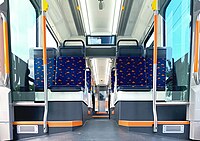Draft:RNT 2020
Submission declined on 24 March 2024 by Trainsandotherthings (talk).
Where to get help
How to improve a draft
You can also browse Wikipedia:Featured articles and Wikipedia:Good articles to find examples of Wikipedia's best writing on topics similar to your proposed article. Improving your odds of a speedy review To improve your odds of a faster review, tag your draft with relevant WikiProject tags using the button below. This will let reviewers know a new draft has been submitted in their area of interest. For instance, if you wrote about a female astronomer, you would want to add the Biography, Astronomy, and Women scientists tags. Editor resources
|  |
 Comment: Needs more than one independent, secondary source to show notability. Trainsandotherthings (talk) 15:33, 24 March 2024 (UTC)
Comment: Needs more than one independent, secondary source to show notability. Trainsandotherthings (talk) 15:33, 24 March 2024 (UTC)
| Rhein-Neckar-Tram 2020 | |||||||||||||||
|---|---|---|---|---|---|---|---|---|---|---|---|---|---|---|---|
 Škoda ForCity Smart 36T | |||||||||||||||
| |||||||||||||||
| |||||||||||||||
| |||||||||||||||
| |||||||||||||||
The Rhein-Neckar-Tram 2020 (RNT 2020) (manufacturer name ForCity Smart 36T, 37T and 38T) is a series of low-floor tram by Škoda Transportation for the Rhein-Neckar metropolitan region. The RNT 2020 is to be used on all lines of the Rhein-Neckar-Verkehr GmbH (RNV) and will replace vehicles built between 1960 and 2000.
General Information
[edit]The Rhein-Neckar-Tram 2020 is designed as a bi-directional vehicle. This is particularly important for its use in Heidelberg due to the low number of turning loops. The model type with doors on both sides makes it possible to use it overland, as there are many stations with platforms on both sides. The trams can reach a maximum speed of 80 km/h.
Order
[edit]The order covers 80 vehicles at a cost of 265 million euros. The trams are build at the Czech manufacturer Škoda Transportation at locations in Czechia and Finland. Basis for the RNT 2020 is the Škoda Artic.[1]
The 37- and 38T variants are designed as partial bi-directional vehicles with only one cab and doors on both sides and are used exclusively in double traction. The other ends of the vehicles are equipped with a gangway that allows passengers to access the entire tram. The advantage of this is that in the event of a fault, only the affected half of the vehicle needs to be repaired and the other half can be reconnected and returned to service.
Multiple tractions should be avoided during rush hours by using the longer trams. Furthermore, there is more space for passengers in the same space and two driver's cabs can be saved per vehicle. The 60-meter cars are currently the longest meter-gauge streetcars in the world.[2]
The vehicles have been delivered since October 2022. The first RNT 2020 arrived in Ludwigshafen between 2:30 and 3:00 a.m. on the morning of October 18, 2022.
Usage
[edit]The first carriage, with number 1402 (type 36T), went into service on April 14, 2023, almost three years late, at the start of the Bundesgartenschau in Mannheim.
The vehicles have been in operation on Mannheim Line 2 between Neckarstadt West and Feudenheim since October 9, 2023. They are now also in use on line 3 and as driving school vehicles. Since the end of January 2024, the first 37T full train 1803/1804 of the RNT has been in regular service on line 3 between Sandhofen and Rheingoldhalle. Since February 8, 2024, the 1408 and 1409 have been operating as traction on Line 1 between Schönau and Rheinau Bahnhof.
-
36T-Tram, TW 1401, at Mannheim Hbf
-
37T full train, consisting of TW 1801 and TW 1802, on Lindenhof overpass
-
RNT interior
-
Transition joint between TW 1801 and 1802
-
Rear of the 1804
-
Information display
Weblinks
[edit]References
[edit]- ^ Jens Bernhardt (2023-04-16). "Die neue Rhein-Neckar-Tram von Skoda geht in den Fahrgastbetrieb". Urban Transport Magazine. Retrieved 2023-04-18.
- ^ "Verbesserungen und Neuerungen – Rhein-Neckar-Tram 2020". Retrieved 2023-10-24.







- in-depth (not just passing mentions about the subject)
- reliable
- secondary
- independent of the subject
Make sure you add references that meet these criteria before resubmitting. Learn about mistakes to avoid when addressing this issue. If no additional references exist, the subject is not suitable for Wikipedia.